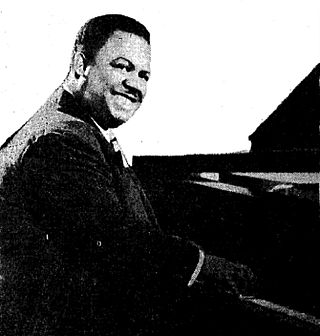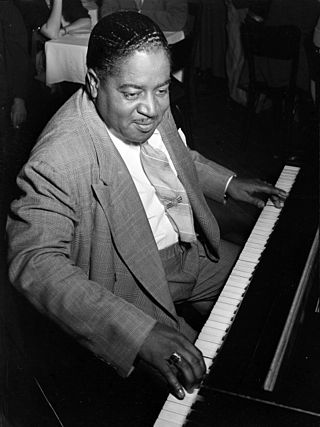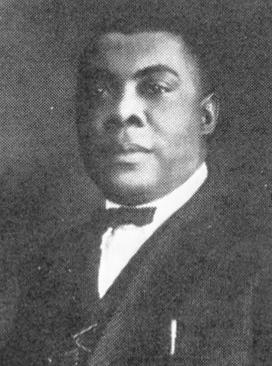Boogie woogie musicians are those artists who are primarily recognized as writing, performing, and recording boogie woogie music.
Boogie woogie musicians are those artists who are primarily recognized as writing, performing, and recording boogie woogie music.
James Edward Yancey was an American boogie-woogie pianist, composer, and lyricist. One reviewer described him as "one of the pioneers of this raucous, rapid-fire, eight-to-the-bar piano style".
Boogie-woogie is a genre of blues music that became popular during the late 1920s, developed in African-American communities since the 1870s. It was eventually extended from piano to piano duo and trio, guitar, big band, country and western music, and gospel. While standard blues traditionally expresses a variety of emotions, boogie-woogie is mainly dance music. The genre had a significant influence on rhythm and blues and rock and roll.

Anderson Meade "Lux" Lewis was an American pianist and composer, remembered for his playing in the boogie-woogie style. His best-known work, "Honky Tonk Train Blues", has been recorded by many artists.

William Thomas "Champion Jack" Dupree was an American blues and boogie-woogie pianist and singer. His nickname was derived from his early career as a boxer.

Albert Clifton Ammons was an American pianist and player of boogie-woogie, a blues style popular from the late 1930s to the mid-1940s.

Kermit Holden "Pete" Johnson was an American boogie-woogie and jazz pianist.
Clarence "Pinetop" Smith, was an American boogie-woogie style blues pianist. His hit tune "Pine Top's Boogie Woogie" featured rhythmic "breaks" that were an essential ingredient of ragtime music, but also a fundamental foreshadowing of rock and roll. The song was also the first known use of the term "boogie woogie" on a record, and cemented that term as the moniker for the genre.

George Washington Thomas Jr. was an American blues and jazz pianist and songwriter. He wrote several influential early boogie-woogie piano pieces including "The New Orleans Hop Scop Blues", "The Fives", and "The Rocks", which some believe he may have recorded himself under the name Clay Custer.
Restvale Cemetery is in Alsip, Illinois, United States, a suburb southwest of the city of Chicago. A number of Chicago blues musicians, educators, and notable people are buried there.
Rufus George Perryman, known as Speckled Red, was an American blues and boogie-woogie piano player and singer noted for his recordings of "The Dirty Dozens", exchanges of insults and vulgar remarks that have long been a part of African-American folklore.
Erwin Helfer is an American boogie-woogie, blues and jazz pianist. Helfer is a Chicago boogie-woogie and jazz innovator, performer, and educator.

This is a timeline documenting events of Jazz in the year 1974.

This is a timeline documenting events of Jazz in the year 1985.

Mitch Woods is an American modern day boogie-woogie, jump blues and jazz pianist and singer. Since the early 1980s he has been touring and recording with his band, the Rocket 88s. Woods calls his music, "rock-a-boogie," and with his backing band has retrospectively provided a 1940s and 1950s jump blues style.
Robert Shaw was an American blues and boogie-woogie pianist, best known for his 1963 album, The Ma Grinder.
William Ezell, was an American blues, jazz, ragtime and boogie-woogie pianist and occasional singer, who was also billed as Will Ezell. He regularly contributed to recordings made by Paramount Records in the late 1920s and early 1930s. Ezell was noted by the music journalist Bruce Eder as "a technically brilliant pianist, showing the strong influence of jazz as well as blues in his work".

Boogie Woogie is a compilation album containing four 10-inch, 78 rpm records of boogie-woogie music. The songs on the album were recorded over a period of three years from 1936 to 1939, then released in 1941 on this compilation album by Columbia Records (C44). Artists featured on the album include Harry James, Count Basie, Big Joe Turner, and the three prominent boogie-woogie pianists of the time, Albert Ammons, Pete Johnson, and Meade Lux Lewis.
This is a timeline documenting events of Jazz in the year 1913.
This is a timeline documenting events of Jazz in the year 1907.
Thomas F. McFarland, known professionally as Barrelhouse Buck McFarland was an American blues and boogie-woogie pianist, singer and composer. He first recorded material in the early 1930s, but had to wait until three decades later, before providing his 'barrelhouse' swan song.